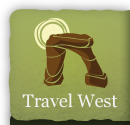Zion Archeology
Perhaps the earliest dwellers of the Zion National Park region were the Paiute Indians. Archeologists have found evidence that indicates that they lived in the area as early as the year 7000 BC. This tribe appeared to live in small family based groups and hunted animals and gathered wild food found in the area.

The Fremont Indian tribe lived in the northwestern corner of the area at the same time as the Pueblo Indians lived in Zion. Like the Pueblo tribes, they farmed and left the area at about the same time.
Southern Paiute Indians were farming in Zion Canyon when the first white settlers arrived in the area to establish homesteads in the area in the 1850s. These settlers were Mormon pioneers sent by their prophet, Brigham Young, to establish a cotton mission in the area. While this cotton endeavor did not last, the Mormon settlers remained and several of the local towns – like Springdale, Rockville, St. George, and Hurricane – were first started by them.
Of note, it was the Mormon pioneers that named Zion National Park’s main canyon “Zion” – an ancient Hebrew word that means a place of sanctuary. To them the beautiful canyon with its majestic rock formations and color palette conjured feelings of peace and reverence. Many of landmarks in the national park – like Angels Landing and the Great White Throne – reflect this pseudo religious heritage.

Did you like this page? Did you find it helpful? Please consider sharing.
